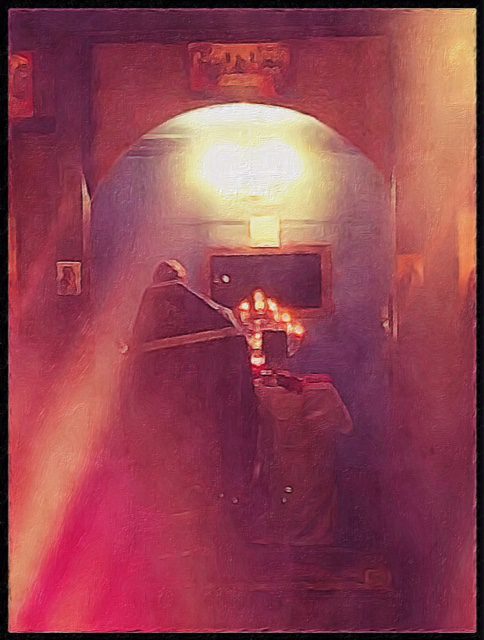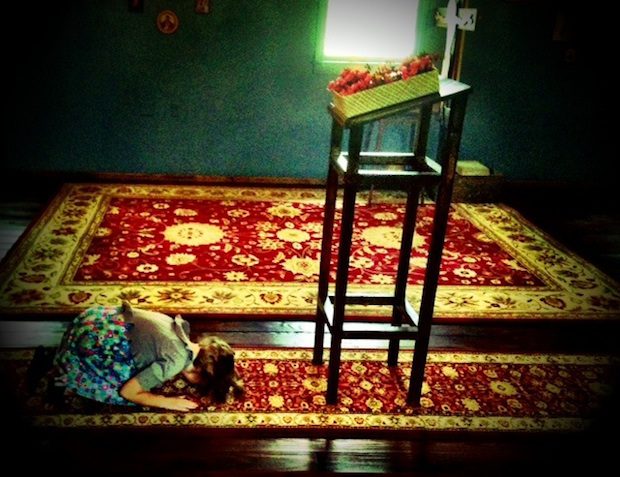An Orthodox Story Ends

Sunday’s liturgy was the final one to be celebrated at St. John the Evangelist Orthodox mission by Father Matthew Harrington. Note that I did not say the final liturgy. The mission is staying open for prayer and Bible study, with liturgies once or twice a month celebrated by visiting priests. St. John’s is not closing. But its founding priest and his family are moving this week back to their home state of Washington. We did not have enough members in our parish to support a full-time priest and his family. So, after three and a half years, this chapter in the life of the Orthodox Church and its members in one pocket of the South comes to a close.
Of course I’m sad, but I’ve done my mourning. We gave it our all, but it didn’t work out. I’m thinking now about how much the last three years of worship at St. John’s changed me and my family for the better.
This image, which I’ve published here before, says a lot:
That’s my daughter Nora, who was six when this picture was taken, early in the life of the mission. She is bowing before the Holy Cross, which lays flat among flowers atop this stand. St. John’s was where my little girl learned to prostrate herself before the Cross. Don’t misunderstand — other Orthodox churches do this too. But this is where she learned it. It’s where I learned it too, in my bones. I’ve been doing this since I became Orthodox in 2006, but life in the mission made Orthodoxy real for me in a way that it had not been before.
If you read my book How Dante Can Save Your Life, you can glean the heart of this story. In essence, being in a small church where all hands were needed pulled me out of my natural tendency to stand outside and analyze. Without understanding what I was doing, before St. John’s (and before Orthodoxy), I had an essentially consumeristic way of living out life in church. True, I was aware that the “What can I get out of church?” attitude is wrong, and I don’t think that was quite my own sin here. Mine was more sophisticated. I was all judgey about people who took that approach, but I was pretty hypocritical, because I didn’t think about what I could and should be giving to the community, other than writing a tithe check.
You couldn’t do that at St. John’s. Even so, I was the least active of our flock, in part because our time there coincided with my chronic mono, which made me useless in working outside most of the time. Still, you showed up for liturgy and everything else, even when you didn’t necessarily want to, because the church needed you to show up, and because, let’s face it, you need to be there for your own sake. For me, this was the first church at which I have felt “all-in”. It’s not that no other church offered me that opportunity, but that for the first time in my life as a Christian, I was compelled to do what I needed to do to go all-in.
It’s no coincidence that the unanticipated failure of my prodigal son return to family forced me to embrace the church at a deeper level than ever before. The church became my rock. Father Matthew led me over some steep, sharp terrain in the confessional, as I came to terms with some hard truths. I came to love the things I found harsh at first. For example, our mission church is in ROCOR, the Russian church in exile (though now reunited with the Moscow Patriarchate). ROCOR has a practice of not giving communion on Sunday morning to one who does not show up for Vespers (evening prayer) the night before. Most other Orthodox churches, at least in this country, do not observe that tradition. For Father Matthew, it was non-negotiable.
Well, I just hated that. Who wants to go to church for 45 minutes at 6pm on Saturday night? It’s Saturday night! But if you wanted to receive communion the next morning, you had to choose. So we went to vespers. After a while, it was so normal that the weekend didn’t feel right without it.
These are the changes that take place within you when you put serving God in the life of the local church at the center of your life. I could have affirmed that intellectually before St. John’s, but now I can testify to it from experience. Heaven knows we were a far from perfect parish, but still, having lived Orthodoxy like this for three years, I can’t be satisfied with returning to what I was before St. John’s entered into my life.
I know I could not have written How Dante without St. John’s. To be honest, I don’t know what would have happened to me, spiritually, emotionally, and physically, without the grace and mercy that God sent to me through this parish family and the ministry of its priest. If the book I’m finishing now, The Benedict Option: A Strategy For Christians In A Post-Christian Nation, is of any use to the church in America, it will have a lot to do with what I learned firsthand at St. John’s, a tiny mission in Starhill, La., that punched far above its weight.
Father Matthew and his family came down to a town on the Mississippi River, cast a line in the water, but did not have a good catch. But who knows what God may do next with St. John’s, which, as I said, will remain open. I would be lying to say that I find it nothing short of tragic that an Orthodox priest as gifted as Father Matthew will be returning to civilian life, so to speak, because there are no parishes available. He is and always will be a priest, but back in Washington, he will have to do an office job to pay the bills.
Here’s how I will remember him, in a photo illustration I made from a shot I took during a liturgy. This is him at the altar, behind the iconostasis, praying the liturgy. This image looks timeless. Father Matthew was a priest, he is a priest, and he will be a priest again, in full-time ministry, one day. It’s so clearly what he was made to be. We were lucky to have had him, and so will the parish one day that calls that man to be their pastor.


Subscribe for as little as $5/mo to start commenting on Rod’s blog.